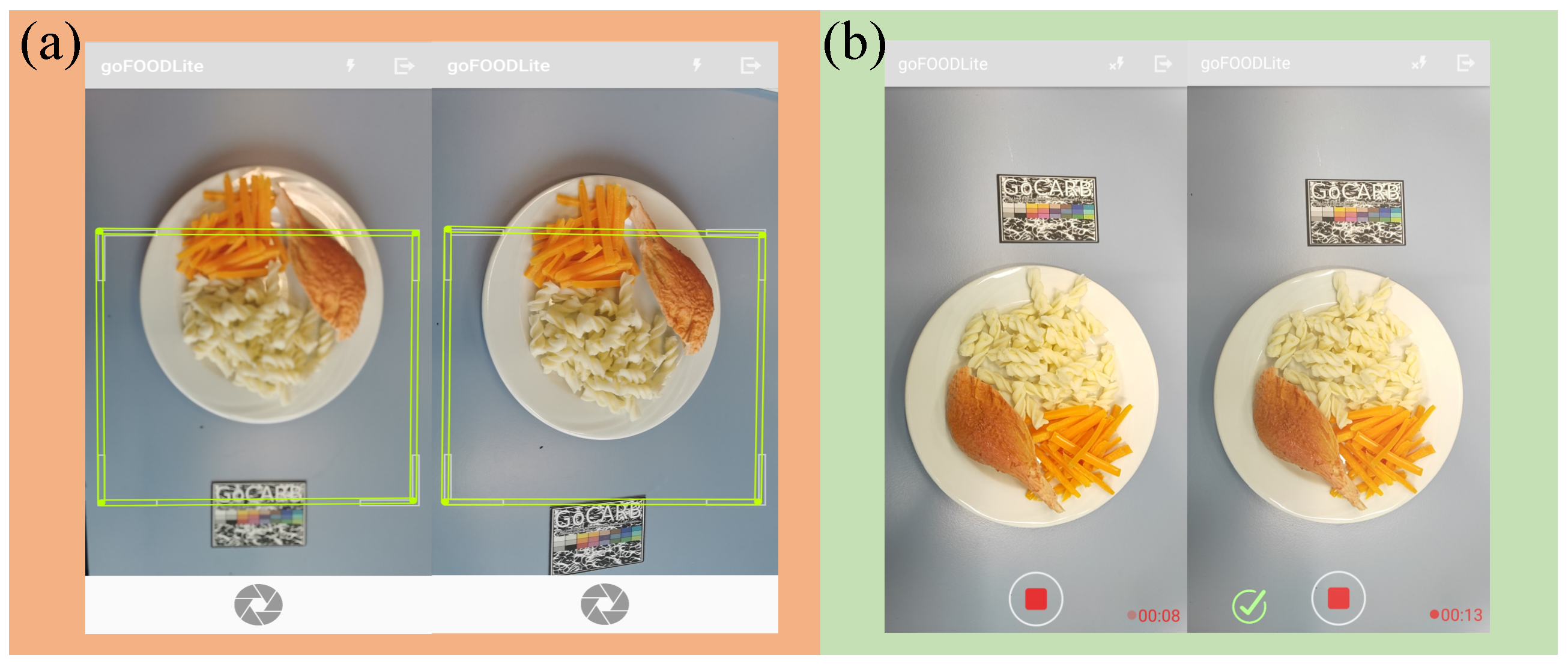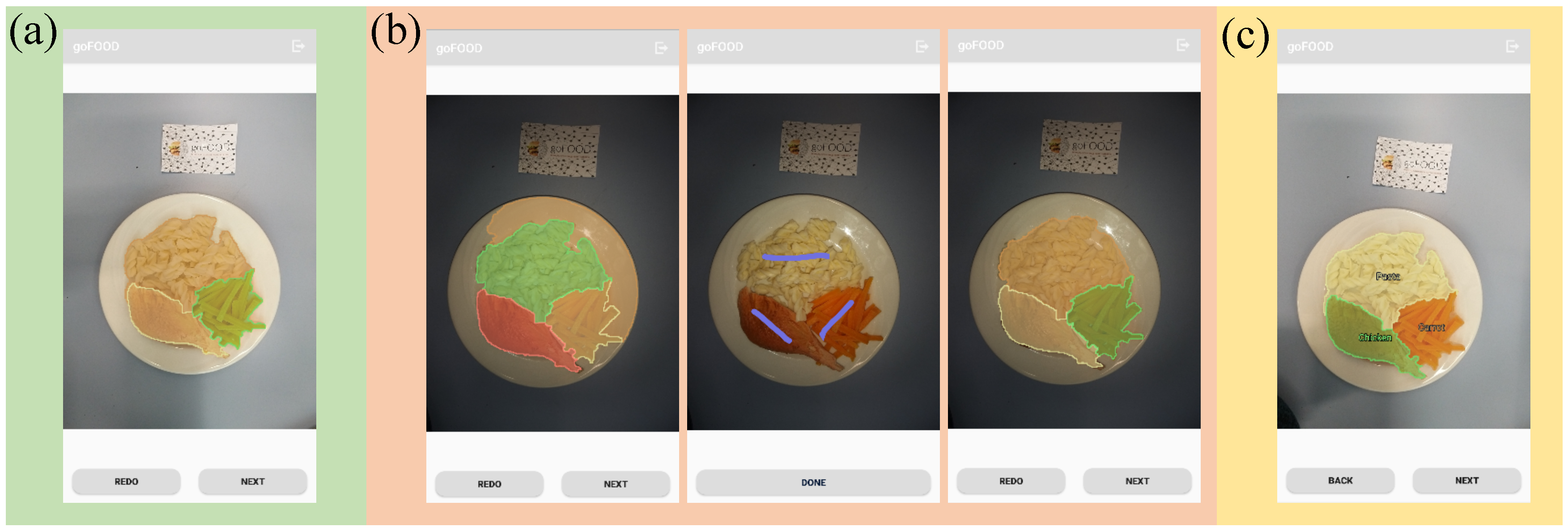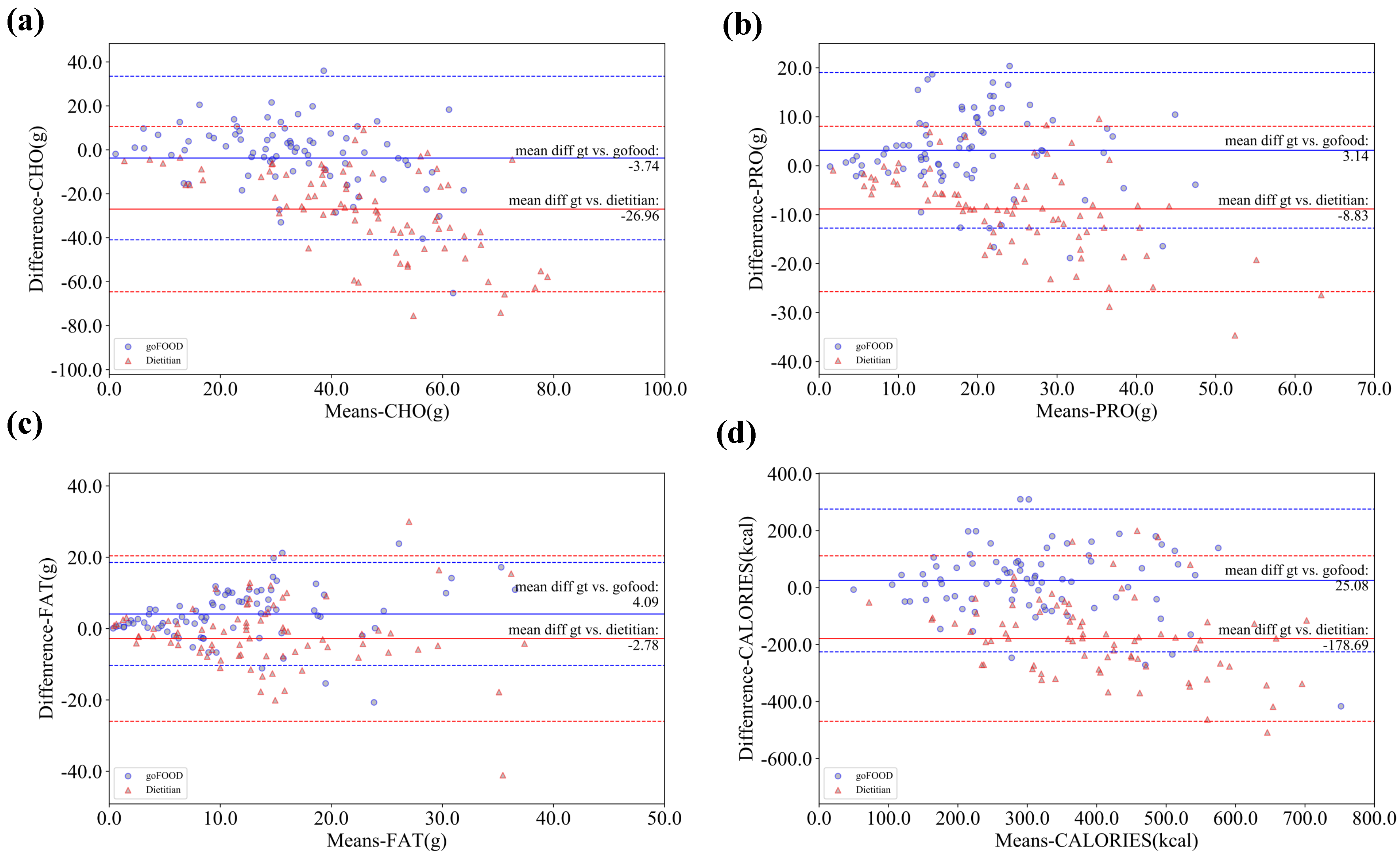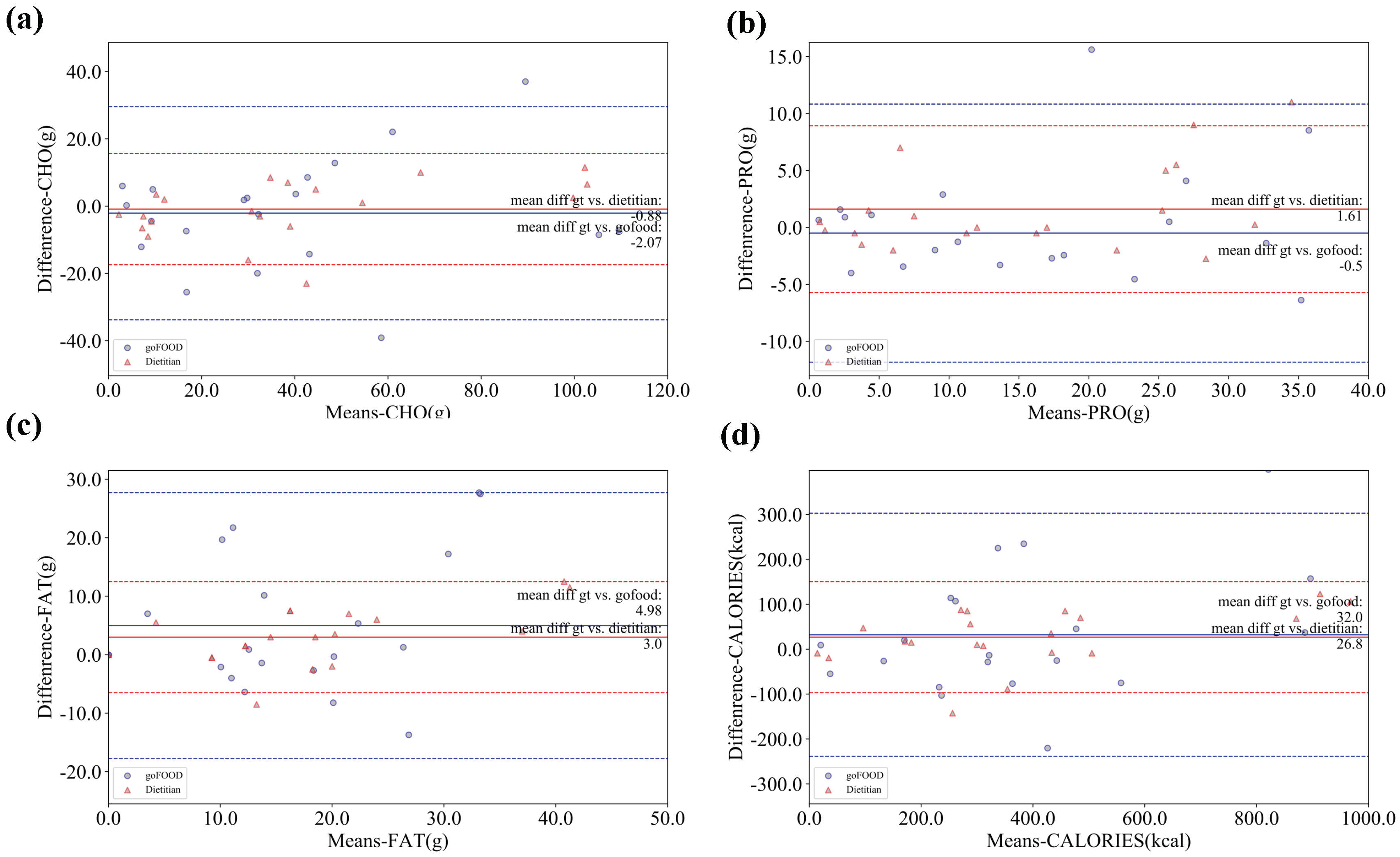goFOODTM: An Artificial Intelligence System for Dietary Assessment
Abstract
1. Introduction
- We propose a practical, accurate, smartphone-based dietary assessment system that predicts the macronutrient (CHO, PRO, Fat) and calorie content of a meal using two images. The experimental results demonstrate the superior performance of the proposed system with respect to the state-of-the-arts on two food databases.
- A new database (“Fast food” database) is introduced. The database contains both food images captured from different views and stereo image pairs. Moreover, the accurate nutrient ground truth and the estimations of the dietitians are also provided. We plan on making this database publicly available to contribute to the dietary assessment research society.
- We have conducted a study that compares our system’s estimation to the estimations of experienced dietitians, demonstrating the promising advantage of an AI-based system for dietary assessment.
2. System Outline
2.1. Food Image Acquisition
2.2. Food Segmentation
2.3. Food Recognition
2.4. Food Volume Estimation
2.5. Nutrient Estimation
2.6. Pipeline Setup
3. Experimental Analysis
3.1. Evaluation Databases
3.2. Dietitians’ Estimation
4. Results
4.1. Food Image Processing
4.2. Nutrient Estimation
5. Discussion and Conclusions
Author Contributions
Funding
Conflicts of Interest
Disclaimer
Abbreviations
| AI | artificial intelligence |
| CHO | carbohydrate |
| PRO | protein |
Appendix A. High-Level Comparison between goFOODTM and Some Popular Commercial Dietary Assessment Apps
| APP name 1 | Automatic Food Recognition | Automatic Food Portion Estimation | Core Algorithm | Computa- Tional Time 2 | Validation |
|---|---|---|---|---|---|
| FatSecret [27] | × | × | - | <1 s | - |
| CALORIE MAMA [28] | √ | × | CNN for food recognition | <1 s | - |
| bitesnap [29] | √ | × | CNN for food recognition | <1 s | - |
| aical [42] | √ | × | Voice recognition aided food recognition | <1 s | - |
| GoCARB 3 previous version of goFOODTM | √ | √ | Traditional machine learning for food recognition, segmentation; SfM for food 3D model reconstruction (volume calculation) | ∼2 s for food recognition and segmentation; ∼5 s for volume estimation | · Technical · Pre-clinical · Clinical |
| goFOODTM 4 | √ | √ | CNN for food recognition, segmentation; Improved SfM for food 3D model reconstruction (volume calculation) | <1 s for food recognition and segmentation; ∼2 s for food volume estimation | · Technical · Pre-clinical ongoing, 2020 |
Appendix B. Macronutrient Estimation from the Dietitians
Appendix C. Food Categories
| 1st Level | 2nd Level | Fine Categories |
|---|---|---|
| Bread | white | garlic bread |
| non white | ||
| Pasta | white | couscous, spaghetti, penne with tomato sauce, etc. |
| non white | ||
| stuffed pasta | ravioli, spinach tortellini, etc. | |
| Potatoes | None | french fries, boiled potatoes with skin, etc. |
| Pulses/legumes | None | peas, poi, etc. |
| Rice | white | pilaf, etc. |
| non white | wild rice, etc. | |
| Fish and Seafood | None | oyster, clam food, lutefisk, etc. |
| Fruit | None | acerolas, pineapples, apples, etc. |
| Meat | processed products | sausage products, galantine, etc. |
| white meat | fried chicken, creamy chicken, turkey with cheese, etc. | |
| red meat | meatballs, steak au poivre, etc. | |
| Dairy products | yoghurt | plain yoghurt, mixed yoghurt |
| white cheese | hard white cheese, cottage cheese, etc. | |
| yellow cheese | fondue | |
| Eggs | boiled/baked | boiled egg, deviled egg, etc. |
| fried | omelette, frittata, etc. | |
| Sweets | None | churro, panna cotta, flan, etc. |
| Vegetables | None | carrots, mushrooms, string beans, etc. |
| Mixed | gratins | casserole, ziti, tamale pie, etc. |
| salads | green salad, beet salad, seaweed salad, etc. | |
| open sandwiches | tostada, bruschetta, huevos rancheros, etc. | |
| closed sandwiches | hamburger, lobster roll sandwich, club sandwich, etc. | |
| stuffed food | dumpling, burrito, gyoza, etc. | |
| pizza | ||
| multilayer | lasagna, moussaka, etc. | |
| soup | wonton, pho, miso soup, etc. | |
| noodles/pasta | chow mein | |
| rice | biryani, pad thai, bibimbap, etc. | |
| meat | coq au vin, moo moo gai pan, etc. | |
| fish | lobster thermidor, fish and chips, etc. | |
| other | kedgeree, guacamole, sushi, etc. | |
| Breaded (incl. croquettes) | None | falafel, tempura, samosa, etc. |
| Corn | None | |
| Nuts | None | pecan, hazelnut, etc. |
| Snack | None | chips, nachos, etc. |
| Cereal | processed | |
| unprocessed |
References
- American Diabetes Association. Cardiovascular disease and risk management: Standards of medical care in diabetes. Diabetes Care 2020, 43, S111–S134. [Google Scholar] [CrossRef] [PubMed]
- American Diabetes Association. Economic costs of diabetes in the U.S. in 2017. Diabetes Care 2018, 41, 917–928. [Google Scholar] [CrossRef] [PubMed]
- Smart, C.E.; King, B.R.; McElduff, P.; Collins, C.E. In children using intensive insulin therapy, a 20-g variation in carbohydrate amount significantly impacts on postprandial glycaemia. Diabet. Med. 2012, 29, e21–e24. [Google Scholar] [CrossRef]
- Brazeau, A.S.; Mircescu, H.; Desjardins, K.; Leroux, C.; Strychar, I.; Ekoé, J.M.; Rabasa-Lhoret, R. Carbohydrate counting accuracy and blood glucose variability in adults with type 1 diabetes. Diabetes Res. Clin. Pract. 2013, 99, 19–23. [Google Scholar] [CrossRef]
- Franziska, K.B.; David, M.M.; Gail, S.; Darcy, O.; Georgeanna, J.K.; Andrey, B.; Joan, T.; Elizabeth, J.M. The carbohydrate counting in adolescents with Type 1 Diabetes (CCAT) Study. Diabetes Spectr. 2009, 22, 56–62. [Google Scholar]
- Smart, C.E.; Ross, K.; Edge, J.A.; King, B.R.; McElduff, P.; Collins, C.E. Can children with type 1 diabetes and their caregivers estimate the carbohydrate content of meals and snacks? Diabet. Med. 2009. [Google Scholar] [CrossRef] [PubMed]
- World Health Organization (WHO). Diet, Nutrition and the Prevention of Chronic Diseases. Available online: https://www.who.int/dietphysicalactivity/publications/trs916/en/ (accessed on 22 July 2020).
- Voulodimos, A.; Doulamis, N.; Doulamis, A.; Protopapadakis, E. Deep learning for computer vision: A brief review. Comput. Intell. Neurosci. 2018, 2018. [Google Scholar] [CrossRef] [PubMed]
- Guo, Y.; Liu, Y.; Oerlemans, A.; Lao, S.; Wu, S.; Lewa, M.S. Deep learning for visual understanding: A review. Neurocomputing 2016, 187, 27–48. [Google Scholar] [CrossRef]
- Leo, M.; Furnari, A.; Medioni, G.G.; Trivedi, M.; Farinella, G.M. Deep learning for assistive computer vision. In Proceedings of the European Conference on Computer Vision, Zurich, Switzerland, 6–12 September 2014; pp. 3–14. [Google Scholar]
- Anthimopoulos, M.; Gianola, L.; Scarnato, L.; Diem, P.; Mougiakakou, S. A food recognition system for diabetic patients based on an optimized bag of features model. IEEE J. Biomed. Health Inform. 2014, 18, 1261–1271. [Google Scholar] [CrossRef] [PubMed]
- Ciocca, G.; Napoletano, P.; Schettini, R. Food recognition: A new dataset, experiments and results. IEEE J. Biomed. Health Inform. 2016, 21, 588–598. [Google Scholar] [CrossRef] [PubMed]
- Jiang, S.; Min, W.; Liu, L.; Luo, Z. Multi-scale multi-view deep feature aggregation for food recognition. IEEE Trans. Image Process. 2020, 29, 265–276. [Google Scholar] [CrossRef] [PubMed]
- Meyers, A.; Johnston, N.; Rathod, V.; Korattikara, A.; Gorban, A.; Silberman, N.; Guadarrama, S.; Papandreou, G.; Huang, J.; Murphy, K.P. Im2Calories: Towards an Automated Mobile Vision Food Diary. In Proceedings of the IEEE International Conference on Computer Vision (ICCV), Santiago, Chile, 7–13 December 2015; pp. 1233–1241. [Google Scholar] [CrossRef]
- Bally, L. Carbohydrate estimation supported by the GoCARB system in individuals with type 1 diabetes: A randomized prospective pilot study. Diabetes Care 2017, 40, dc162173. [Google Scholar] [CrossRef] [PubMed]
- Bossard, L. Food-101—Mining discriminative components with random forests. In Proceedings of the European Conference on Computer Vision (ECCV), Zurich, Switzerland, 6–12 September 2014; pp. 446–461. [Google Scholar]
- Kawano, Y.; Yanai, K. Automatic expansion of a food image dataset leveraging existing categories with domain adaptation. In Proceedings of the European Conference on Computer Vision Workshop (ECCVW), Rhodes, Greece, 10–16 March 2014; pp. 3–17. [Google Scholar]
- Puri, M.; Zhu, Z.; Yu, Q.; Divakaran, A.; Sawhney, H. Recognition and volume estimation of food intake using a mobile device. In Proceedings of the IEEE Workshop on Applications of Computer Vision, Snowbird, UT, USA, 7–8 December 2009; pp. 1–8. [Google Scholar]
- Kong, F.; Tan, J. DietCam: Automatic dietary assessment with mobile camera phones. J. Pervasive Mob. Comput. 2012, 8, 147–163. [Google Scholar] [CrossRef]
- Dehais, J.; Anthimopoulos, M.; Shevchik, S.; Mougiakakou, S. Two-view 3D reconstruction for food volume estimation. IEEE Trans. Multimed. 2017, 19, 1090–1099. [Google Scholar] [CrossRef]
- Vasiloglou, M.F.; Mougiakakou, S.; Aubry, E.; Bokelmann, A.; Fricker, R.; Gomes, F.; Guntermann, C.; Meyer, A.; Studerus, D.; Stanga, Z. A comparative study on carbohydrate estimation: GoCARB vs. Dietitians. Nutrients 2018, 10, 741. [Google Scholar] [CrossRef] [PubMed]
- Anthimopoulos, M.; Dehais, J.; Shevchik, S.; Botwey, R.; Duke, D.; Diem, P.; Mougiakakou, S. Computer vision-based carbohydrate estimation for type 1 diabetic patients using smartphones. J. Diabetes Sci. Technol. 2015, 9, 507–515. [Google Scholar] [CrossRef] [PubMed]
- Rhyner, D.; Loher, H.; Dehais, J.; Anthimopoulos, M.; Shevchik, S.; Botwey, R.H.; Duke, D.; Stettler, C.; Diem, P.; Mougiakakou, S. Carbohydrate estimation by a mobile phone-based system versus self-estimations of individuals with type 1 diabetes mellitus: A comparative study. J. Med. Internet Res. JMIR 2016, 18, e101. [Google Scholar] [CrossRef] [PubMed]
- Ege, T.; Yanai, K. Image-based food calorie estimation using knowledge on food categories, ingredients and cooking directions. In Proceedings of the on Thematic Workshops of ACM Multimedia, Mountain View, CA, USA, 23–27 October 2017; pp. 367–375. [Google Scholar]
- Fang, S.; Shao, Z.; Mao, R.; Fu, C.; Kerr, D.A.; Boushey, C.J.; Delp, E.J.; Zhu, F. Single-view food portion estimation: Learning image-to-energy mappings using generative adversarial networks. In Proceedings of the IEEE International Conference on Image Processing, Athens, Greece, 7–10 October 2018; pp. 26–30. [Google Scholar]
- Lu, Y.; Allegra, D.; Anthimopoulos, M.; Stanco, F.; Farinella, G.M.; Mougiakakou, S. A multi-task learning approach for meal assessment. In Proceedings of the Joint Workshop on Multimedia for Cooking and Eating Activities and Multimedia Assisted Dietary Management (CEA/MADiMa ’18), Stockholm, Sweden, 15 July 2018; pp. 46–52. [Google Scholar] [CrossRef]
- FatSecret. Available online: https://www.fatsecret.com (accessed on 22 July 2020).
- CALORIE MAMA. Available online: https://dev.caloriemama.ai (accessed on 22 July 2020).
- Bitesnap. Available online: https://getbitesnap.com (accessed on 22 July 2020).
- Allegra, D.; Anthimopoulos, M.; Dehais, J.; Lu, Y.; Stanco, F.; Farinella, G.M.; Mougiakakou, S. A multimedia database for automatic meal assessment systems. In Proceedings of the International Conference on Image Analysis and Processing (ICIAP), Catania, Italy, 11–15 September 2017. [Google Scholar]
- He, K.; Gkioxari, G.; Dollár, P.; Girshick, R. Mask R-CNN. In Proceedings of the IEEE International Conference on Computer Vision (ICCV), Venice, Italy, 22–29 October 2017; pp. 2980–2988. [Google Scholar] [CrossRef]
- Szegedy, C.; Vanhoucke, V.; Ioffe, S.; Shlens, J.; Wojna, Z. Rethinking the inception architecture for computer vision. In Proceedings of the IEEE Conference on Computer Vision and Pattern Recognition (CVPR), Las Vegas, NV, USA, 27–30 June 2016. [Google Scholar]
- Hassannejad, H.; Matrella, G.; Ciampolini, P.; De Munari, I.; Mordonini, M.; Cagnoni, S. Food image recognition using very deep convolutional networks. In Proceedings of the 2nd International Workshop on Multimedia Assisted Dietary Management, Amsterdam, The Netherlands, 16 October 2016; pp. 41–49. [Google Scholar] [CrossRef]
- Kaur, P.; Sikka, K.; Wang, W.; Belongie, S.; Divakaran, A. FoodX-251: A Dataset for Fine-grained Food Classification. In Proceedings of the IEEE International Conference on Computer Vision and Pattern Recognition Workshop (CVPRW), Long Beach, CA, USA, 16–20 June 2019. [Google Scholar]
- Nutritionix Database. Available online: https://www.nutritionix.com/database (accessed on 22 July 2020).
- U.S. Department of Agriculture: FoodData Central. Available online: https://ndb.nal.usda.gov/ndb/ (accessed on 22 July 2020).
- Swiss Food Composition Database. Available online: https://www.naehrwertdaten.ch/en/ (accessed on 22 July 2020).
- Dehais, J.; Anthimopoulos, M.; Mougiakakou, S. Dish Detection and Segmentation for Dietary Assessment on Smartphones. In Proceedings of the 8th International Conference on Image Analysis and Processing (ICIAP2015), Genoa, Italy, 7–8 September 2015; pp. 433–440. [Google Scholar]
- Dehais, J.; Anthimopoulos, M.; Mougiakakou, S. Food image segmentation for dietary assessment. In Proceedings of the 2nd International Workshop on Multimedia Assisted Dietary Management, Amsterdam, The Netherlands, 16 October 2016; ACM: New York, NY, USA, 2016. [Google Scholar]
- Krizhevsky, A.; Sutskever, I.; Hinton, G.E. ImageNet classification with deep convolutional neural networks. In Proceedings of the International Conference on Neural Information Processing Systems, Doha, Qatar, 12–15 November 2012; pp. 1097–1105. [Google Scholar]
- Bhanu, B.; Symosek, P.; Snyder, S.; Roberts, B.; Das, S. Synergism of binocular and motion stereo for passive ranging. IEEE Trans. Aerosp. Electron. Syst. 1994, 30, 709–721. [Google Scholar] [CrossRef][Green Version]
- Aical-Photo & Voice Calories Counter. Available online: https://apps.apple.com/gb/app/aical-calories-counter/id1484771102 (accessed on 22 July 2020).
Sample Availability: Datasets for the presented experiments can be made available after communication with the authors. |








| Methods | (%) | (%) |
|---|---|---|
| [38]-Region growing & merging | 67.8 | 90.8 |
| [30]- | 70.6 | 92.9 |
| [30]- | 74.3 | 93.7 |
| goFOODTM | 83.9 | 94.4 |
| Methods | Hyper1 | Hyper2 | Fine-Grained | |||
|---|---|---|---|---|---|---|
| Top-1 (%) | Top-3 (%) | Top-1 (%) | Top-3 (%) | Top-1 (%) | Top-3 (%) | |
| Inception-V3 [32] | 63.2 | 83.7 | 47.0 | 70.5 | 53.9 | 73.6 |
| goFOODTM | 65.8 | 82.4 | 61.5 | 78.2 | 57.1 | 71.8 |
| goFOODTM Median (25th– 75th Percentiles) | Dietitians Median (25th–75th Percentiles) | |
|---|---|---|
| CHO (g) | 7.2 (3.2–15.3) | 27 (10.6–37.7) |
| PRO (g) | 4.5 (2.0–10.9) | 8.7 (4.7–13.5) |
| Fat (g) | 5.2 (2.0–10.06) | 5.2 (2.3–9.7) |
| Calories (kcal) | 74.9 (40.4–139.3) | 180 (119–271) |
| Two-View Median (25th–75th Percentiles) | Stereo Pair Median (25th–75th Percentiles) | Dietitians Median (25th–75th Percentiles) | |
|---|---|---|---|
| CHO (g) | 7.9 (4.2–15.7) | 9.3 (3.5–14.1) | 5.3 (2.9–7) |
| PRO (g) | 2.8 (1.3–4.20) | 4.4 (2.9–7.5) | 1.5 (0.5–3.3) |
| Fat (g) | 5.8 (1.4–14.6) | 9.22 (3.9–22.5) | 3.8 (1.5–6.3) |
| Calories (kcal) | 75.9 (27.9–124.7) | 107.8 (54.8–150.9) | 55.5 (17–83) |
| Database | goFOODTM vs. Ground Truth | Dietitians vs. Ground Truth | goFOODTM vs. Dietitians | |
|---|---|---|---|---|
| MADiMa | CHO | |||
| PRO | ||||
| Fat | ||||
| Calories | ||||
| Fast Food | CHO | |||
| PRO | ||||
| Fat | ||||
| Calories |
© 2020 by the authors. Licensee MDPI, Basel, Switzerland. This article is an open access article distributed under the terms and conditions of the Creative Commons Attribution (CC BY) license (http://creativecommons.org/licenses/by/4.0/).
Share and Cite
Lu, Y.; Stathopoulou, T.; Vasiloglou, M.F.; Pinault, L.F.; Kiley, C.; Spanakis, E.K.; Mougiakakou, S. goFOODTM: An Artificial Intelligence System for Dietary Assessment. Sensors 2020, 20, 4283. https://doi.org/10.3390/s20154283
Lu Y, Stathopoulou T, Vasiloglou MF, Pinault LF, Kiley C, Spanakis EK, Mougiakakou S. goFOODTM: An Artificial Intelligence System for Dietary Assessment. Sensors. 2020; 20(15):4283. https://doi.org/10.3390/s20154283
Chicago/Turabian StyleLu, Ya, Thomai Stathopoulou, Maria F. Vasiloglou, Lillian F. Pinault, Colleen Kiley, Elias K. Spanakis, and Stavroula Mougiakakou. 2020. "goFOODTM: An Artificial Intelligence System for Dietary Assessment" Sensors 20, no. 15: 4283. https://doi.org/10.3390/s20154283
APA StyleLu, Y., Stathopoulou, T., Vasiloglou, M. F., Pinault, L. F., Kiley, C., Spanakis, E. K., & Mougiakakou, S. (2020). goFOODTM: An Artificial Intelligence System for Dietary Assessment. Sensors, 20(15), 4283. https://doi.org/10.3390/s20154283






